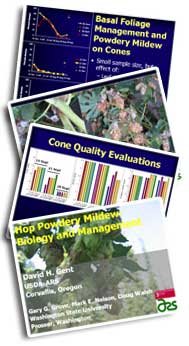Plant Pathology in Hop, Year 2
In our second project year, we focused on
- Impacts of basal foliage management on disease development and persistance
- Maturity level of cones correlated to disease incidence
- Last spray date impacts
We observed that, with respect to relative disease incidence and cone maturity, the greatest level of susceptibility occurred during the plant's transition from burr to cone. As the cones matured and neared harvest, the susceptibility to disease decreased, but if disease did occur, the resulting browning was more pronounced.
With respect to last spray date, results were somewhat different than in Year 1. Unlike the previous year, wherein controls through late July proved most impactful, this year showed more positive results for late-season (through August 12) control
- 16 to 28% cone yield increase
- >1% alpha acid increase
- >0.5% beta acid increase
- 30% total alpha acid yield (yield x % alpha acid)
- improved cone color
Click here to view a slide show including additional data and images pertaining to Year 2. (Large file, download may take several minutes.)
Click here to see information on Year 1.
Plant Pathology subpage
This page is designed to provide additional information pursuant to the Plant Pathology component of the overall project discussed on the Washington State University website http://hopmintstress.wsu.edu.
It is not designed to be viewed or utilized independently of that website.
Return to Plant Pathology page.
Return to home page.
Slide show depicting Year 2 research efforts. (Large file, download may take several minutes.)
